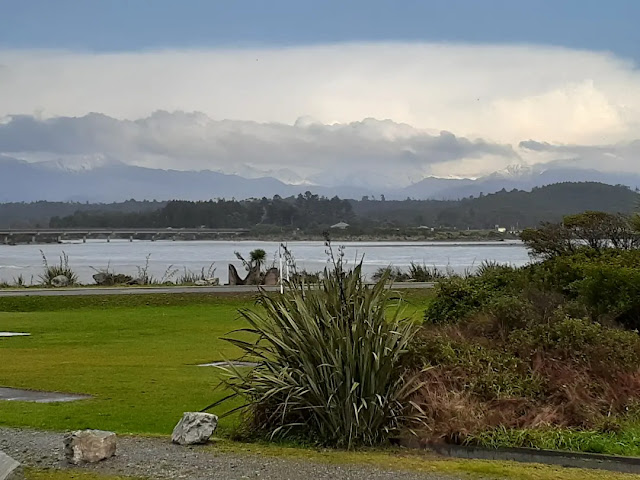There is something about Hokitika that has stolen my heart. On the face of it it is just another small town on the west coast of New Zealand's South Island, struggling with the after effects of our long covid lockdowns, like so many other small towns, but for me Hokitika is still the whole package. Not only does it have a rich history dating back before European settlement, very friendly locals and a whole host of heritage buildings, but it is also a centre for artists and is blessed with a stunning landscape. As a big city dweller and all that goes with living in a big city, a trip to Hokitika is refreshing and really makes my heart sing.
 |
| View from Hokitika to the alps and New Zealand's highest mountain, Mt Cook |
The town of Hokitika was founded in 1864 as the centre of the West Coast gold rush. It's hard to believe now, with its current population of around 3000, that in 1866 it was one of New Zealand's most populated centres boasting the busiest port in the country and 101 hotels. The town's major industries were greenstone, gold, coal and forestry. As those industries have declined they have been replaced by dairy farming and increasingly, ecotourism.
 |
A standout feature of Hokitika is the wild and wonderful beach which runs the length of the town. I could happily spend endless hours walking the beach in any sort of weather. On my recent visit the weather was wet and wild and I was mesmerised by the waves rolling in and crashing on the shore. It was quite other worldly. The beach is strewn with driftwood which the locals celebrate each year with the Driftwood and Sand festival. People come from all over New Zealand and overseas to view and admire the intricate sculptures and the town's famous "Hokitika" sign sculptured from driftwood. The popular Wild Foods festival in March celebrates all sorts of weird and wonderful food.
I am a great lover of heritage buildings and Hokitika has a lot to choose from. Get a map for the heritage trail from the information centre, as I did, and take a two hour stroll around town to view them.
 |
| The locals fought hard to save their art deco cinema, now beautifully restored |
 |
| The Customs House dating from 1897 |
.JPG) |
| Old Government Buildings built between 1909 and 1911 |
I love the friendliness of Hokitika. I called into the local stationers and ended up having a long friendly chat with the owner. One evening I had dinner at Stumpers restaurant, great food and a warm and welcoming atmosphere. I was on my own but had pleasant conversations with people at the nearby tables, that doesn't often happen in a big city. One of the things I really enjoyed was joining the locals to greet a large contingent of motor scooter riders who had braved the freezing temperatures to ride over the mountain pass from Christchurch to raise money for charity. For just a few moments I felt like a local although it is said that unless you are born on the coast you can never call yourself a coaster!
 |
| Hanging with the locals, fun times. |
NOTE: The novel The Luminaries by Eleanor Catton, winner of the Man Booker prize in 2013 is set in Hokitika.
www.coollittletown.com
